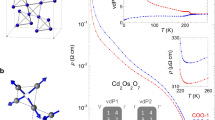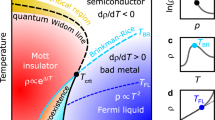Abstract
The metal–insulator transition in correlated electron systems, where electron states transform from itinerant to localized, has been one of the central themes of condensed-matter physics for more than half a century. The persistence of this question has been a consequence both of the intricacy of the fundamental issues and the growing recognition of the complexities that arise in real materials, when strong repulsive interactions play the primary role. The initial concept of Mott was based on the relative importance of kinetic hopping (measured by the bandwidth) and onsite repulsion of electrons. Real materials, however, have many further degrees of freedom that, as is recently attracting note, give rise to a rich variety of scenarios for a ‘Mott transition’. Here, we report results for the classic correlated insulator MnO that reproduce a simultaneous moment collapse, volume collapse and metallization transition near the observed pressure, and identify the mechanism as collapse of the magnetic moment due to an increase of crystal-field splitting, rather than to variation in the bandwidth.
This is a preview of subscription content, access via your institution
Access options
Subscribe to this journal
Receive 12 print issues and online access
$259.00 per year
only $21.58 per issue
Buy this article
- Purchase on Springer Link
- Instant access to full article PDF
Prices may be subject to local taxes which are calculated during checkout





Similar content being viewed by others
References
Mott, N. F. The Basis of the electron theory of metals, with special reference to the transition metals. Proc. Phys. Soc. Lond. A 62, 416–422 (1949).
Mott, N. F. Metal–insulator transition. Rev. Mod. Phys. 40, 677–683 (1968).
Imada, M., Fujimori, A. & Tokura, Y. Metal–insulator transitions. Rev. Mod. Phys. 70, 1039–1263 (1998).
Saitoh, T., Bouquet, A. E., Mizokawa, T. & Fujimori, A. Systematic variation of the electronic structure of 3d transition-metal compounds. Phys. Rev. B 52, 7934–7938 (1995).
Noguchi, Y., Kusaba, K., Fukuoka, K. & Syono, Y. Shock-induced phase transition of MnO around 90 GPa. Geophys. Res. Lett. 23, 1469–1472 (1996).
Mita, Y. et al. Optical study of MnO under pressure. Phys. Status Solidi B 223, 247–251 (2001).
Mita, Y., Izaki, D., Kobayashi, M. & Endo, S. Pressure-induced metallization of MnO. Phys. Rev. B 71, 100101 (2005).
Patterson, J. R. et al. Pressure-induced metallization of the Mott insulator MnO. Phys. Rev. B 69, 220101 (2004).
Yoo, C. S. et al. First-order isostructural Mott transition in highly compressed MnO. Phys. Rev. Lett. 94, 115502 (2005).
Rueff, J.-P., Mattila, A., Badro, J., Vankò, G. & Shukla, A. Electronic properties of transition-metal oxides under high pressure revealed by X-ray emission spectroscopy. J. Phys. Condens. Matter 17, S717–S726 (2005).
Metzner, W. & Vollhardt, D. Correlated lattice fermions in dimensions. Phys. Rev. Lett. 62, 324–327 (1989).
Georges, A., Kotliar, G., Krauth, W. & Rozenberg, M. J. Dynamical mean-field theory of strongly correlated fermion systems and the limit of infinite dimensions. Rev. Mod. Phys. 68, 13–125 (1996).
Kotliar, G. & Vollhardt, D. Strongly correlated materials: Insights from dynamical mean-field theory. Phys. Today 57, 53–59 (2004).
Lichtenstein, A. I. & Katsnelson, M. I. Ab initio calculations of quasiparticle band structure in correlated systems: LDA++ approach. Phys. Rev. B 57, 6884–6895 (1998).
Held, K., McMahan, A. K. & Scalettar, R. T. Cerium volume collapse: Results from the merger of dynamical mean-field theory and local density approximation. Phys. Rev. Lett. 87, 276404 (2001).
Savrasov, S., Kotliar, G. & Abrahams, E. Electronic correlations in metallic plutonium within dynamical mean-field picture. Nature 410, 793–795 (2001).
Held, K., Keller, G., Eyert, V., Vollhardt, D. & Anisimov, V. I. Mott-Hubbard metal–insulator transition in paramagnetic V2O3: An LDA+DMFT(QMC) study. Phys. Rev. Lett. 86, 5345–5348 (2001).
Georges, A. Strongly correlated electron materials: Dynamical mean field theory and electronic structure. AIP Conf. Proc. 715, 3–73 (2004).
Held, K. et al. Realistic investigations of correlated electron systems with LDA+DMFT. Phys. Status Solidi B 243, 2599–2631 (2006).
Kotliar, G. et al. Electronic structure calculations with dynamical mean field theory. Rev. Mod. Phys. 78, 865–951 (2006).
Kuneš, J., Anisimov, V. I., Lukoyanov, A. V. & Vollhardt, D. Local correlations and hole doping in NiO: A dynamical mean field study. Phys. Rev. B 75, 165115 (2007).
Kuneš, J., Anisimov, V. I., Skornyakov, S. L., Lukoyanov, A. V. & Vollhardt, D. NiO: Correlated band structure of a charge-transfer insulator. Phys. Rev. Lett. 99, 156404 (1997).
Cohen, R. E., Mazin, I. I. & Isaak, D. G. Magnetic collapse in transition metal oxides at high pressure: Implications for the Earth. Science 275, 654–657 (1997).
Fang, Z., Solovyev, I. V., Sawada, H. & Terakura, K. First principles study on electronic structures and phase stability of MnO and FeO under high pressure. Phys. Rev. B 59, 762–774 (1999).
Kasinathan, D. et al. Mott transition of MnO under pressure: comparison of correlated band theories. Phys. Rev. B 74, 195110 (2006).
Kasinathan, D., Koepernik, K. & Pickett, W. E. Pressure-driven magnetic moment collapse in the ground state of MnO. New J. Phys. 9, 235–246 (2007).
McMahan, A. K., Held, K. & Scalettar, R. T. Thermodynamic and spectral properties of compressed Ce calculated using a combined local-density approximation and dynamical mean field theory. Phys. Rev. B 67, 075108 (2003).
McMahan, A. K. Combined local-density and dynamical mean field theory calculations for the compressed lanthanides Ce, Pr, and Nd. Phys. Rev. B 72, 115125 (2005).
van Elp, J., Potze, R. H., Eskes, H., Berger, R. & Sawatzky, G. A. Electronic structure of MnO. Phys. Rev. B 44, 1530–1537 (1991).
Liebsch, A. Mott transitions in multiorbital systems. Phys. Rev. Lett. 91, 226401 (2003).
Koga, A., Kawakami, N., Rice, T. M. & Sigrist, M. Orbital-selective Mott transitions in the degenerate Hubbard model. Phys. Rev. Lett. 92, 216402 (2004).
Anisimov, V. I., Zaanen, J. & Andersen, O. K. Band theory and Mott insulators: Hubbard U instead of Stoner I. Phys. Rev. B 44, 943–954 (1991).
Werner, P. & Millis, A. J. High-spin to low-spin and orbital polarization transitions in multiorbital Mott systems. Phys. Rev. Lett. 99, 126405 (2007).
Savrasov, S. Y. & Kotliar, G. Spectral density functionals for electronic structure calculations. Phys. Rev. B 69, 245101 (2004).
Shick, A., Havela, L., Kolorenc, J. & Drchal, V. Multiplet effects in the electronic structure of δ-Pu, Am and their compounds. Europhys. Lett. 77, 17003 (2007).
Pavarini, E. et al. Mott transition and suppression of orbital fluctuations in orthorhombic 3d1 perovskites. Phys. Rev. Lett. 92, 176403 (2004).
Craco, L., Laad, M. S., Leoni, S. & Muller-Hartmann, E. Insulator–metal transition in the doped 3d1 transition metal oxide LaTiO3 . Phys. Rev. B 70, 195116 (2004).
Hirsch, J. E. & Fye, R. M. Monte Carlo method for magnetic impurities in metals. Phys. Rev. Lett. 56, 2521–2524 (1986).
Anisimov, V. I. et al. Full orbital calculation scheme for materials with strongly correlated electrons. Phys. Rev. B 71, 125119 (2005).
Shick, A. B, Liechtenstein, A. I. & Pickett, W. E. Implementation of the LDA+U method using the full potential linearized augmented plane wave basis. Phys. Rev. B 60, 10763–10769 (1999).
Anisimov, V. I. & Gunnarsson, O. Density functional calculation of effective Coulomb interactions in metals. Phys. Rev. B 43, 7570–7574 (1991).
Scalettar, R. T., Noack, R. M. & Singh, R. R. P. Ergodicity at large couplings with the determinant Monte Carlo algorithm. Phys. Rev. B 44, 10502–10507 (1991).
Jarrell, M. & Gubernatis, J. E. Bayesian inference and the analytic continuation of imaginary-time quantum Monte Carlo data. Phys. Rep. 269, 133–195 (1996).
Acknowledgements
J.K. gratefully acknowledges the Research Fellowship of the Alexander von Humboldt Foundation. We acknowledge numerous discussions with D. Vollhardt and A. K. McMahan, and useful interaction with K.-W. Lee during the latter stages of this work. This work was supported by SFB 484 of the Deutsche Forschungsgemeinschaft (J.K.), by the Russian Foundation for Basic Research under the grants RFFI-06-02-81017, RFFI-07-02-00041 (V.I.A. and A.V.L.) and the Dynasty Foundation (A.V.L.), by DOE grant No. DE-FG02-04ER46111 and by DOE Strategic Science Academic Alliance grant No. DE-FG01-06NA26204. This research was also encouraged and supported by the US Department of Energy’s Computational Materials Science Network (J.K., R.T.S. and W.E.P.).
Author information
Authors and Affiliations
Contributions
J.K. wrote the code and performed the DMFT (QMC) calculations. J.K., R.T.S., W.E.P. and V.I.A. formulated the approach and chose the application to MnO. A.V.L. and V.I.A. calculated the LDA quantities and carried out the Wannier transformation to the local representation. J.K. and W.E.P. wrote the paper.
Corresponding author
Supplementary information
Rights and permissions
About this article
Cite this article
Kuneš, J., Lukoyanov, A., Anisimov, V. et al. Collapse of magnetic moment drives the Mott transition in MnO. Nature Mater 7, 198–202 (2008). https://doi.org/10.1038/nmat2115
Received:
Accepted:
Published:
Issue Date:
DOI: https://doi.org/10.1038/nmat2115
This article is cited by
-
The first-order structural transition in NiO at high pressure
Communications Physics (2023)
-
Pressure-induced antiferromagnetic-tetragonal to nonmagnetic-collapse-tetragonal insulator-metal transition in ThMnAsN
Journal of Materials Science (2023)
-
Pressure-induced high-spin/low-spin disproportionated state in the Mott insulator FeBO3
Scientific Reports (2022)
-
Electronic correlation in nearly free electron metals with beyond-DFT methods
npj Computational Materials (2022)
-
Systematic beyond-DFT study of binary transition metal oxides
npj Computational Materials (2019)



